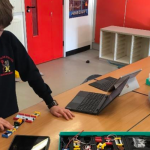In today’s world, the importance of STEM education goes far beyond classrooms, laboratories, and workplaces designated for these branches. Our daily life and relationship with the world are predominantly determined by the insights of STEM.
The four letters and the disciplines they represent (science, technology, engineering, and mathematics) may seem intimidating. One might think, sceptically, at first glance: “How can younger children who don’t yet know basic mathematical concepts be introduced to STEM?”
Where there’s a will, there is a way! And especially in the case of the powerful cross-disciplinary universe of STEM, there are plenty of ways. Whether they have just started preschool or they are heading towards middle school, all children can build a fun and nurturing relationship with STEM.
In this article, we will take a look into what STEM education means for kids, how it can be applied in the learning processes of younger children, and the importance of STEM education in elementary schools and preschools.
What is STEM education for kids?
STEM education includes all sorts of professional and preparatory training in science, technology, engineering, and mathematics. For adults, this means a more pragmatic and professional skills-oriented kind of education. When we talk about STEM education for kids, it’s a slightly different story.
Surely every child is unique in their interests and talents. But a universal feature shared by children of all ages and backgrounds is a natural curiosity. For kids, STEM education precisely targets this. It nurtures children’s curiosity into an organic interest in science and builds the foundations of mental and motor skills that can later be matured into professional STEM expertise.
What does STEM stand for in preschool and primary education?
STEM stands for the fields of Science, Technology, Engineering, and Mathematics. As with all other educational journeys, the best time to start STEM learning is in early childhood. The first five years of human life are especially critical for cognitive development.
Of course, this does not mean teaching Java or other coding languages to preschoolers who don’t yet have any literacy skills. The importance of STEM education in elementary schools and preschool comes from laying the foundations for more advanced STEM skills. In fact, STEM education for primary school students starts from real-life scenarios and easily accessible materials which will help them relate to and get engaged with more complex topics.
With an amalgamation of learning and play, children are introduced to basic STEM concepts and encouraged to adopt a scientific mindset. Hands-on learning experiences enable younger kids to ask questions, explore the answers through trial and error, and build analytical skills such as problem-solving and reasoning.
Why is STEM education so important?
STEM education benefits pre-elementary and elementary stage children in so many ways. A well-rounded education is expected to prepare children to succeed and prosper later in life. For 21st-century individuals, STEM is no longer just a field of expertise, but very much embedded in daily life. Even in today’s world, basic STEM competence and digital literacy are among commonly sought features in the skilled workforce.
The United Nations have included STEM education and literacy as a key factor in accomplishing the 17 UN Sustainable Development Goals (SDGs) laid out in the 2030 Agenda for Sustainable Development. It is thus fair to say that the importance of STEM education has been recognized as a motor for global sustainable development and prosperity, especially in the next 10 years.
Meanwhile, science and maths continue to be compelling courses for many primary students who have a hard time enjoying the abstract concepts and relations between the ideas. With quality STEM education, these obstacles in earlier school levels can be overcome, and the creative potential of students can be unlocked.
Importance of STEM education implementation in elementary schools
STEM education is a lifelong journey that should start as soon as possible. According to the US National Research Council, the core ideas specific to disciplines and the cross-disciplinary concepts of STEM need to be taught from kindergarten through primary and secondary schooling, continuing later in higher education.
How is an integrated STEM education different from the already existing science and mathematics curricula? Elementary STEM education for kids draws connections between science, technology, and mathematics to help children develop an interdisciplinary mindset.
Whether children will end up pursuing STEM-related careers or not, through integrated STEM education at early ages, they gain 21st-century skills of spatial reasoning, problem-solving, being proactive, creative, and unafraid to experiment through trial and error.
Different STEM Activities for Children Between Ages 7-12
We have mentioned how STEM education is not limited to classrooms. Children are already prone to asking “why” and “how” questions about the world, and most of them can be answered via observation and experiment.
This means that parents can play a supplementary role for K-12 STEM learning with different activities. There are plenty of ways you can help encourage kids with STEM learning, but in a nutshell, it comes down to an approach combining play and work–a hands-on minds-on active learning process. Here are some activity ideas to acquaint early elementary children with STEM:
Outdoor scavenger hunts
Scavenger hunts are the epitome of the hands-on, minds-on approach. Setting up different challenges and goals (for example, a spring scavenger hunt for specific plants and animals) will motivate children to explore and appreciate their environment, and get closely acquainted with nature like true scientists!
Scavenger hunts are especially great for cultivating skills such as problem-solving, communication, following cues and rules, creative thinking, spatial memory, and learning through observation.
DIY STEM Projects
A key feature of STEM is that it allows for creativity, inventiveness, and innovation. Remember how you would play with ordinary objects for hours as a child, making armours from blankets and rocket ships from cardboard boxes? Even with the simplest home items, you can encourage your child to explore their inner engineer, working towards building a certain product and solving a certain problem.
In fact, you can do so even without using any materials. You can play a brainstorming game, such as “The Shoe Factory Mishap”—imagine a shoe factory that produced 100 unpaired extra left shoes. What could be done with these shoes? Come up with 100 ways to use them! Here’s the first one: a very avant-garde vase.
Experiments in the kitchen
The kitchen can turn into a perfect home laboratory for young curious minds. Think about it from their perspective: myriad ingredients leading to different reactions when combined, measuring, mixing, using heat, boiling, cooling, and exploring matter in all states—liquids, solids, gases!
Even the simplest recipe, your go-to cake, for example, can be astonishing as you go through the steps. For younger children, this is an opportunity to learn by doing, and see how biochemistry plays out in daily life.
Online STEM courses and games
Thanks to our highly digitized world, you no longer need complicated and inaccessible equipment to teach your children STEM skills. There are plenty of online STEM education tools and resources, as well as STEM sets for children to guide little ones through an interactive learning process.
Twin app offers thousands of free STEM-related trivia and ideas for fun STEM experiments and activities to try at home. Children can also share their creations with their peers and share their passions with one another, while parents are offered monthly reports to track their child’s progress, areas of interest, and areas of improvement.
How to Use Twin Sets as Part of STEM Education
Twin’s minds-on, hands-on education with STEM kits and app offers a holistic hybrid learning journey for ages 7-12. The Twin STEM sets are tailor-made with the insight gained through fieldwork with 20,000+ children, aiming to instill the love of science in children.
The Twin Coding Kit features magnetic LEGO-compatible modules which, combined with the Twin mobile app, introduce children to the world of coding! For younger children and for those with an artistic side, the Robotic Art Kit combines the LEGO-compatible technological modules with endless creative possibilities. Twin Curiosity Kit is the perfect STEM starter kit for kids who want to get into robotics and try their hand at making innovative inventions.
Last but not least, the award-winning Twin Autonomous Vehicle Kit allows children to design self-driving vehicles powered by artificial intelligence, and control the car through the app themselves!
There are over 1000 projects on the Twin app, some of which use the modules in the STEM kits, and others that can be easily completed with everyday objects found at and around the home.
What’s more, Twin’s online STEM education and coding lessons for kids employ a double-winged approach that combines STEM learning with a sense of ethical duty toward the world. Not only do children develop STEM skills and explore the limits of their imagination, but they also learn about current global issues and come up with solutions, from climate change to alternative, sustainable energy sources and zero waste.
Start your child’s online STEM education journey today, and give them the gift of skills they will use for a lifetime!




